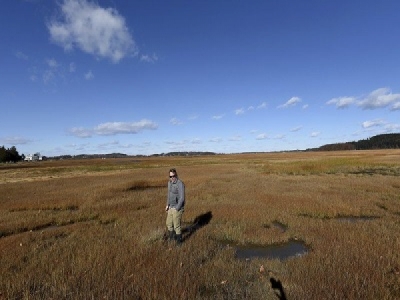
Posted on November 19, 2018
The National Wildlife Federation was awarded a $1.2 million grant earlier this month from the newly created National Coastal Resilience Fund to continue efforts to restore and strengthen the Great Marsh, which stretches from Cape Ann up through Newburyport to the New Hampshire border.
The grant is boosted by $1.3 million from various state projects and nonprofit organizations involved with the marsh, which arches north from Gloucester to Essex, Ipswich, Rowley, Newbury, Newburyport and Salisbury.
The $2.5 million in total will go toward drainage of marsh pools, restoration of native vegetation such as eelgrass, and removal of invasive species.
“The town has been involved for several years working with state and federal partners to better understand the potential effects of climate change and sea level rise on the marsh,” said Essex Town Administrator Brendhan Zubricki.
“One concern the town has is that the salt marsh may not be able to keep pace with sea level rise,” he said. “The salt marsh platform generally provides a great amount of protection against storm surges and waves and currents produced by storms.”
On a sustainable path
Chris Hilke, a coastal resilience senior manager with the National Wildlife Federation (NWF), said a variety of factors — including sea level rise, restricted water flow, local development, and more extreme, frequent nor’easters and rain — are “beginning to take a toll” on the marsh.
This spring, NWF completed some restoration work on the marsh that was funded by a separate $2.9 million grant first awarded by the U.S. Department of the Interior in June 2014.
After receiving the grant, the NWF and a coalition of partners conducted community resiliency planning, dune restoration, hydrological barrier assessment, and a large restoration effort that focused on eelgrass and management of invasive species, according to Hilke.
He said a hydrodynamic transport model was also developed for the Great Marsh, as well as the development of long-term strategies to help put the marsh on a sustainable path. This was all funded through the 2014 grant.
Peter Phippen, coastal coordinator for the Massachusetts Bays National Estuary Program, was the project lead on many of those efforts under the original grant.
“This,” he said, referring to the latest grant, “was a continuation, a followup on some of the things that were recommended.
“We’re doing more of that type of work,” Phippen said, “more restoration of native vegetation, through eelgrass restoration, through the removal of two invasive species that have taken hold on the marsh — phragmites australis as well as perennial pepperweed.”
Hilke said phragmites australis and perennial pepperweed put a strain on the marsh, and that the grant will help fund continued efforts to combat the invasive species and plant native vegetation such as eelgrass.
Creating runneling
Hilke also said sea level rise is causing pooling on top of parts of the marsh, which could lead to rot.
“As the marsh gets inundated as a result of sea level rise … and remains inundated for long periods of time,” he said, “pools begin to develop on the marsh platform and expand over time and literally rot out the marsh from inside out.
“The pools grow larger and larger,” Hilke said, “and at the pool edges you just have rotting biomass because they never get the chance to drain.”
Hilke said a technique, known as runneling — where shallow ditches are made to help the marsh drain and move that pooling water into a larger body of water — will be funded by the latest grant.
Phippen agreed that a lack of drainage within the marsh is a problem in some areas.
“We’re looking at mitigating marsh drainage issues with sea level rise,” he said. “There has been an increase in water ponding on the marsh. When you couple that with the mosquito ditching, which is causing different hydrology, we’re looking at some ditch infilling and runneling projects to help drain the marsh in some places and maintain water in other places.”
Work to start in spring
Hilke said he anticipates the next phase of work on the marsh will begin sometime in early 2019. He also said there are a number of groups partnering with NWF on this project, including Boston University, the University of New Hampshire, Merrimack Valley Planning Commission, and Mass Audubon.
Since 2014, he said, hundreds of locals have volunteered to help restoration efforts on the marsh.
The National Coastal Resilience Fund was just created this past May by the National Fish and Wildlife Foundation, with a mission to help restore and strengthen natural resource infrastructure to protect coastal towns and cities from storm damage, flooding, and climate change.
The first round of grants for the fund this fall was paid for by the National Fish and Wildlife Foundation, the National Oceanic and Atmospheric Administration, Shell Oil Company and TransRe.
Across the country, 35 grants were awarded through the fund, totaling $28.9 million. An additional $38.29 million was generated through matching funds.
Source: Gloucester Daily Times





